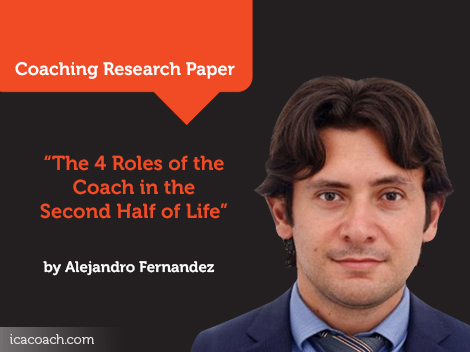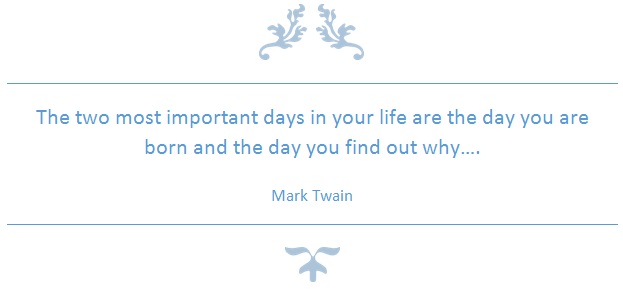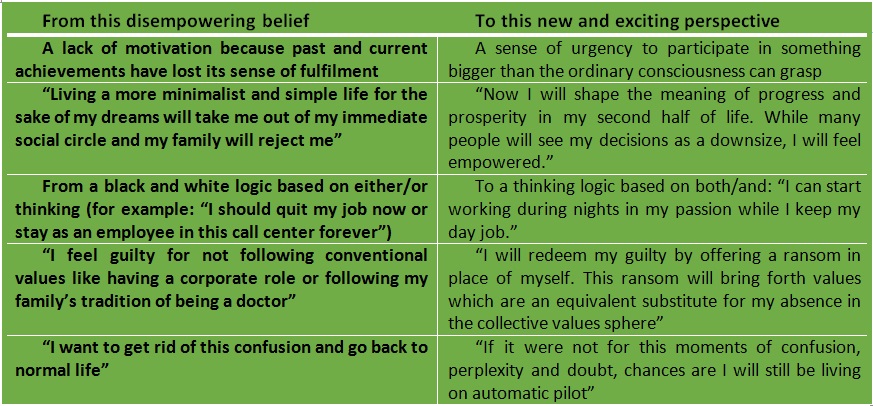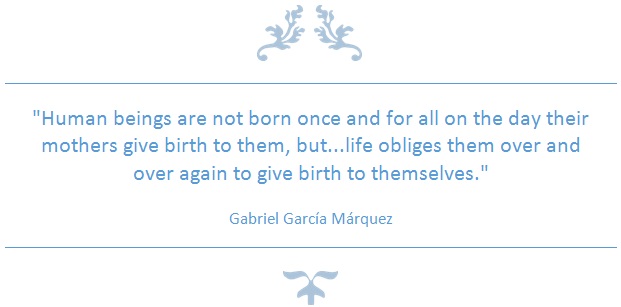 Research Paper By Alejandro Fernandez
Research Paper By Alejandro Fernandez
(Leadership Coach, COSTA RICA)
Tell me, what is it you plan to do with your one wild and precious life? Mary Oliver
Introduction
What is the Second Half of Life?
The second half of life manifests itself as an increasing urge to leave behind beliefs that once provided you with happiness, security and comfort but now only bring you a sensation of incompleteness and not-belongingness.
The appearance of this stage in your life doesn’t necessarily has to do with your age, rather with how you have lived your life to the present, and how tired you are of conventional and obsolete values. There can be multiple triggers, all them leading to the blatant discovery that you have been gradually losing meaning in your life. You start to sense an increasing calling to awaken a dialogue between the conscious and unconscious forces in your mind.
The goal of this incubation phase is to expand your sense of commitment and accountability. You want your life back after years of embodying a false self or identity that was at the service of pleasing others. That is why there is a growing desire to ignite the capacity to create and generate wisdom that leaves a legacy. According to Carl Jung, during the middle passage the process of individuation goes to the next level, in pursue of
the lifelong project of becoming more nearly the person we were meant to be.
 Why are you here? That is the crucial question that resonates in your head when initiating the journey to the second half of life. What circumstances, beliefs and situations brought you to your current state of being? Why everything seems to be good at the surface, but still something is not quite Ok? Do you sense that this life you are having is too small for the burning fire in your heart?
Why are you here? That is the crucial question that resonates in your head when initiating the journey to the second half of life. What circumstances, beliefs and situations brought you to your current state of being? Why everything seems to be good at the surface, but still something is not quite Ok? Do you sense that this life you are having is too small for the burning fire in your heart?
According to author James Hollis, the so called mid-life crisis is an
insurgency of the soul, an overthrow of the ego’s understanding of the self and the world, and a rather demanding invitation to live more consciously in the second half of life.
That description seems wonderful, but the transition is preceded by periods of confusion, disappointment, anger, depression and boredom.
Another particular aspect of the second half is that relationships are transformed and transitioned from the realm of transaction, indulgence and seduction to the realm of true and authentic intimacy. Of course for this transition to be successful, one needs to have the courage to re-configure the social circle and take tough decisions about what relationships are aligned with our new Self. Because of this, and for the very reason that this passage has a turbulent nature, more and more people seek for help and guidance. One of the main tasks of the coach in this process is to facilitate the awakening of inner resources and courage necessary to confront this chapter and make the quantum leap to a life of expanded possibilities.
How to spot someone that is going through the middle passage?
Some people are aware that they are having a mid-life crisis, and some other people don’t. At any case most of them are haunted by uneasiness and discomfort and want to change their current state-of-being. That is why they come in search for a coach.
If you want to become proficient in the art of coaching people with second-life challenges, it is relevant to understand some of its commons traits:
- The individual has been successful according to cultural standards, but knows deep inside that he can give more, and is haunted with the question what’s next?
- Another alternative is that the person hasn’t been successful according to cultural standards and now he or she feels a strong drive to pursue conventional success.
- Priorities in conflict: Work, family and personal interests crash against each other, leaving the person in a state of paralysis and stagnation.
- A sense of certainty of having the intellectual capacity and talent to leave a stronger contribution in life, but struggle to find the motivation and courage to exploit his most sacred gifts.
- A willingness to make a career shift: People look for a deep sense of contribution in their society and to further develop their talents and passions into a way that is profitable for them. Career shift is one of the strongest intentions behind a middle passage.
- Redemption for past errors: Greater awareness of past mistakes ignites the intention to make up for those errors, directly or indirectly.
- Re-configure the vision of love and intimacy: Second half of life represents an opportunity to re-visit our beliefs of what true intimacy is and re-discover the joy of having deeper-meaningful connections.
- Find a deeper spiritual meaning in life: A crisis of spiritual dilemmas or a sense of your whole world falling apart (also known as “Dark Night of the Soul”) triggers a strong intention to look for a more comprehensive vision of the world. A vision that welcomes the paradoxical nature of life and expands the sense of divinity.
Coaching the Second Half of Life
Something is dying in the person that is going through the middle passage. But at the same time something is becoming, gestating and flourishing. This battle of letting go of the past identity and the pain of giving birth to a new one is the epicenter of the coaching process. As a coach, you are contemplating the birth and facilitating the increased awareness required to complete this initiation.
Here is a list of the roles you can play in this “ceremony” in order to be a wise and helpful companion for your client:
Role #1: Provoke a shift of perspective about the middle passage
As coaches, we now that shift of perspective is one of the main tasks in our practice. When applying this principle to the second half of life, we will find that there are some patterns and common believes that jeopardize a successful journey. This disempowering beliefs are the raw material to build new perspectives more attuned with the challenges faced by the customer.
In the table below, there are some examples of transitions from disempowering beliefs to motivating perspectives. My intention is not for you to use them literally in the coaching process, but to have an idea of common patterns of belief and a blueprint in how the coachee can transform them successfully.

Role #2: To acknowledge the customer in the midst of confusion, perplexity and doubt
Despair, sorrow and confusion are common feelings in the arena of second life. Desperate for outside recognition and praise, most people have lost the ability to acknowledge themselves for the marvelous initiation they are going through.
Here are some examples that follow common patterns of acknowledgement in the second half of life. The whole purpose of it is to spark hope and motivation about this wonderful journey you client is having:
Role #3: Stimulate insight through powerful questions
The transition to a more soulful life implies a big dilemma. It is like a fork in the road and you have to decide whether to keep using the same strategies in your early adulthood or re-engineer your worldview and change your direction in life. Most people don’t take any decision, rather they keep wandering in the middle of the fork, not being able to make up their minds.
This lack of decisiveness is lived by the individual as a personal hell. By using powerful questions the coach can bring awareness and help the client understand that he is the builder of the prison he is at, that second life is a time of flourishing not of withering.
Here are some examples of powerful questions that can be used:
Role #4: Bring Lightness to the journey
The Second Half of life has to do a lot with releasing control and letting go of false security schemas. Whether is a decision of shifting careers or take a new horizon in your personal romantic life, the possibility of uncertainty invades the individual. Fear paralyzes him and he feels that is incapable to take the necessary steps to accept the calling and embrace the journey. This is why bringing lightness to this heavy burden is one powerful strategy in the coaching process.
The coachee needs to discover by himself that the rocks he carries in his backpack of beliefs were put in there by himself. The best way to do that is by finding solid evidence that proofs the world can be lighter. Evidence in the stories of other people that have thrived when going through big ordeals, evidence that proves that the size of the struggles are just the right size to match his top talents, evidence that problems look in the mirror bigger than they really are.
 In the second half of life the individual doesn’t switch from significance to lightness, he just discovers that life was always light in the first place. Significance was an illusion of his own creation.
In the second half of life the individual doesn’t switch from significance to lightness, he just discovers that life was always light in the first place. Significance was an illusion of his own creation.
Lightness is contagious, by transmitting your own aura of lightness in the coaching space you can make the client remember that -as John Milton says-
The mind can make a heaven out of hell or a hell out of heaven.
References
Hollis, James. 2005. “Finding Meaning in the Second Half of Life: How to finally, Really Grow Up” Gotham Books
Arrien, Angeles. 1999. “The Second Half of Life” Sounds True.
Hollis, James. “Through the Dark Wood: Finding Meaning in the Second Half of Life” Sounds True.
Hollis, James. “The Middle Passage: From Misery to Meaning in Midlife” BMA Audio.
Marianne Williamson. “The Age of Miracles: Embracing the New Midlife” Hay House